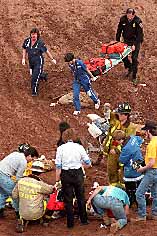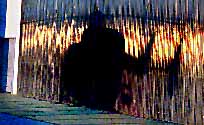 How to Observe, listen, & photograph LIFE STAR medical helicopters
How to Observe, listen, & photograph LIFE STAR medical helicopters


After photographing LIFE STAR for the past 12 years the only safe to observe and capture the excitement of the moment is to
use long lenses! It is imperative that you stay out of the way of the emergency services on site! In this picture on the left, I was using a 300mm lens shooting from the top of a cliff. The accident
victim fell off of his motorbike and fractured his legs. There was plenty of room to get great scene shots from the top of the pit area, yet stay out of everyone way!
 Use (as in this instance) a highway overpass to get a picture of the scene in the foreground, and traffic stopped in the background.
This accident shut down I-91 for over 1 hour, and used both LIFE STAR helicopters to get the victims out.
Use (as in this instance) a highway overpass to get a picture of the scene in the foreground, and traffic stopped in the background.
This accident shut down I-91 for over 1 hour, and used both LIFE STAR helicopters to get the victims out.
 Another thing to look out for at all scenes is the power wires. Where are they? Are they energized? Best bet? Stay away! Don't get caught up in all the action and forget about your safety.
The emergency services personnel have their hands full with the victim(s) at the scene, they sure don't need to be taking care of you. Again, use those long lenses. In this picture taken in Ellington, Ct. I was using a 180mm lens, quite far away from the scene but did manage to get a nice shot of the accident and the helicopter at the same time.
Another thing to look out for at all scenes is the power wires. Where are they? Are they energized? Best bet? Stay away! Don't get caught up in all the action and forget about your safety.
The emergency services personnel have their hands full with the victim(s) at the scene, they sure don't need to be taking care of you. Again, use those long lenses. In this picture taken in Ellington, Ct. I was using a 180mm lens, quite far away from the scene but did manage to get a nice shot of the accident and the helicopter at the same time.

Always keep a watch out for shadows that the helicopter and or other emergency vehicles make. This unique one was of the helicopter during sunrise.

How to listen to LIFE STAR and find out where they are going
You can hear LIFE STAR just about anywhere in central Connecticut on their main dispatch radio frequency of 155.385 with a PL of 123.0.
You can also hear their portables which they carry, on 461.3875 with a PL of 141.3. These portables are low power so you will only hear them around the Hartford, Connecticut area. Each crew member carries a portable with them throughout the hospital when they are on duty.
That way each crew member knows where every other crew member is in case of a call. It is also used on scene, between the pilot and crew in case they have to be
transported away from the aircraft to the incident site.


What you will hear when LIFE STAR gets dispatched.
The first thing you will hear are two tones which pre-announce the type of call that they will be responding to.
Then you will hear the dispatcher announce whether it is a CODE 100, 200, or 300, then the location of the call.
A CODE 100 is an emergency response to a scene where their expertise is needed. Most of the time it will be motor vehicle accidents.
A CODE 200 is an emergency transport from one Emergency Room to another.
And the last, a CODE 300, is an ICU to ICU transport.
Once LIFE STAR is airborne the pilot recieves the exact location and radio frequency to talk to people on the ground once they are in the
general area. The ground support will usually give a landing zone update of any hazards in the area.
After recieving that information the pilot will ask for information on the patients condition. This is to alert the flight nurse, and respiratory therapist so they may be ready for any special
equipment they might need or any treatment they might have to give.
 How to Observe, listen, & photograph LIFE STAR medical helicopters
How to Observe, listen, & photograph LIFE STAR medical helicopters How to Observe, listen, & photograph LIFE STAR medical helicopters
How to Observe, listen, & photograph LIFE STAR medical helicopters

 Use (as in this instance) a highway overpass to get a picture of the scene in the foreground, and traffic stopped in the background.
This accident shut down I-91 for over 1 hour, and used both LIFE STAR helicopters to get the victims out.
Use (as in this instance) a highway overpass to get a picture of the scene in the foreground, and traffic stopped in the background.
This accident shut down I-91 for over 1 hour, and used both LIFE STAR helicopters to get the victims out. Another thing to look out for at all scenes is the power wires. Where are they? Are they energized? Best bet? Stay away! Don't get caught up in all the action and forget about your safety.
The emergency services personnel have their hands full with the victim(s) at the scene, they sure don't need to be taking care of you. Again, use those long lenses. In this picture taken in Ellington, Ct. I was using a 180mm lens, quite far away from the scene but did manage to get a nice shot of the accident and the helicopter at the same time.
Another thing to look out for at all scenes is the power wires. Where are they? Are they energized? Best bet? Stay away! Don't get caught up in all the action and forget about your safety.
The emergency services personnel have their hands full with the victim(s) at the scene, they sure don't need to be taking care of you. Again, use those long lenses. In this picture taken in Ellington, Ct. I was using a 180mm lens, quite far away from the scene but did manage to get a nice shot of the accident and the helicopter at the same time.



